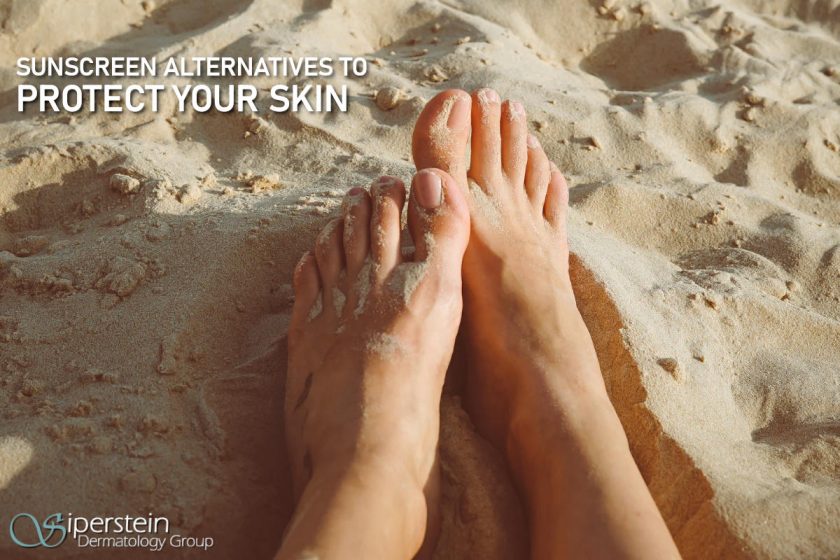At Siperstein Dermatology Group, we understand that not everyone loves sunscreen as much as we do. Sunscreen is a great tool for protecting your skin for the vast majority of our patients. However, there are people for whom sunscreen may be less ideal.
For example, children less than six months of age, pregnant or breast-feeding women, patients allergic to sunscreen ingredients, and even people with limited mobility. In these cases, we recommend seeking out sunscreen alternatives to use exclusively or in combination with sunscreen. Read on for some of our favorite alternatives to traditional sunscreen!
I Dislike The Creamy Feeling Of Sunscreens, Are There Any Non-Greasy Substitutes?
Try a brush-on sunscreen! These portable, self-dispensing brushes have become an extremely popular alternative to traditional sunscreen. They are mineral-based, go-on sheer and offer broad spectrum UVA-UVB coverage. It’s a great tool for your low UV exposure days spent inside the house or office. We do not recommend using it as your primary method of sun protection as the amount applied is likely insufficient to protect the skin, especially if you are spending significant time outside. However, it is great option for sun protection while running quick errands or re-application over makeup. Drop by our office or visit us online to purchase our favorite brand: Brush-on-Block SPF 30!
My Spouse/Child/Friend Refuses To Wear Sunscreen Outdoors—What Do You Recommend They Use?
Our all-time favorite method of sun-protection are clothing and hats with UPF.
The term UPF (Ultraviolet Protection Factor) is used as a measure of ultraviolet radiation penetration through the fabric. For example, a UPF of 50 means that 1/50th (2%) of the UV rays can penetrate the UPF fabric. The higher the UPF, the better.
The UPF of a fabric depends upon the fiber content, weave, fabric finishing and additives. Clothing with UPF 50+ offers the best protection because it is constant, full-skin, full-spectrum protection. You do not need to reapply. You do not need to worry about what area of the skin you missed. And best yet, these clothing actually keep you nice and cool under the sun.
But don’t our clothes already protect us from the sun? Sadly, not very well! The average weight cotton T-shirt gives only a UPF of 5, which translates to 20% of the UV rays reaching your skin. This is inadequate protection when outdoors.
When shopping for your sun-protective clothing and hats, make sure you pay attention to a few things.
- The fabric should be UPF rated 50+, not SPF rated. Clothing that cite SPF do not offer full-spectrum protection.
- Make sure the clothing is durable, meaning that the sun protection the fabric offers will not wash out or wear out over time.
Drop by the Siperstein office during your next visit to check out some of our favorite sun-protective clothing brands in person! Some of our go-to-clothing brands include Coolibar, Solumbra, UV Skinz, and Cabana Life. Hat brands include Wallaroo and Buff.
I Already Have Clothing That I Love Wearing Outdoors—Can I Convert Them To UV Clothing?
Yes, you can! A UV detergent is a photo-protective laundry additive that washes into the clothing and absorbs broadband UV radiation. The brand we recommend is RIT Sun Guard.
A single treatment of RIT Sun Guard embeds clothing with a UPF of 30, meaning only 1/30th (or 3.3%) of the UV rays can penetrate the UPF fabric. Unlike our recommended clothing brands above, which typically maintain the same UPF for hundreds of washes, clothing treated with RIT sun guard will have UPF that only lasts approximately 20 launderings. So, be sure to keep track of your washings!
For those hesitant to purchase UV protective clothing, laundry additives are an inexpensive way to augment your sun protection. You only need one pack of RIT Sun Guard per load of laundry and last we checked on Amazon, a six-pack was $25, making each load of laundry only $4.16! What a bargain for protecting your skin from skin cancer and aging!
Any Other Sun Protective Strategies You Recommend?
Don’t forget to grab your sunglasses that offer UVA UVB broad-spectrum coverage. Chronic UV exposure can increase the risk of cataracts, macular degeneration and many other eye problems. We’re not the eye experts here but are happy to refer you to an ophthalmologist if you have any further questions.


